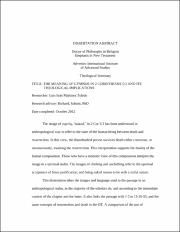| dc.description.abstract | The image of γπκλόο, "naked" in 2 Cor 5:3 has been understood in anthropological way to refer to the state of the human being between death and resurrection. In this view, the disembodied person survives death either conscious, or unconsciously, awaiting the resurrection. This interpretation supports the duality of the human composition. Those who have a monistic view of this composition interpret the image in a spiritual realm. The images of clothing and unclothing refer to the spiritual acceptance of Jesus justification, and being naked means to be with a sinful nature.
This dissertation takes the images and language used in the passage in an anthropological realm, as the majority of the scholars do, and according to the immediate context of the chapter and the letter. It also links the passage with 1 Cor 15:35-55, and the same concepts of resurrection and death in the OT. A comparison of the use of
anthropological terms as they have been used in the LXX to translate related Hebrew terms shows the anthropological and monistic background of the passages. Therefore, the interpretation of γπκλόο goes to a monistic view of the passage.
Γπκλόο refers then to a state of nonexistence, death. The houses, which are used as clothes before and after nakedness, refer to anthropological natures. The logical conclusion is that resurrection is a new creation. The use of γπκλόο, and its relation to other images used by Paul to refer to the same state, reveals an intention to link the identity of the person before death with the identity of the same person after resurrection. In that sense, the one who dies is the same person who will be raised, even though the nature, which is expressed as body, is different. Thus, the person who will receive the reward from God at resurrection is the same who received the promise before death.
Paul presents two processes of changing the human nature: (a) resurrection, that implies having nakedness before; and (b) transformation without experiencing the state of nakedness, which is death. Paul groans desiring to experience the latter, but lies in the hope of resurrection if the former happens.
The image of γπκλόο reinforces the monistic view of life, death, and resurrection. At the same time it highlights the continuity of the identity despite a period of total cessation of existence, and consequently life, which death represents. | en_US |

